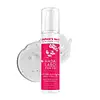What's inside
What's inside
 Key Ingredients
Key Ingredients

 Benefits
Benefits

 Concerns
Concerns

No concerns
 Ingredients Side-by-side
Ingredients Side-by-side

Water
Skin ConditioningButylene Glycol
HumectantGlycerin
HumectantPEG-20 Sorbitan Isostearate
EmulsifyingPhenoxyethanol
PreservativePEG-60 Hydrogenated Castor Oil
EmulsifyingTriethylhexanoin
MaskingPropanediol
SolventPPG-10 Methyl Glucose Ether
Skin ConditioningSodium Hyaluronate
HumectantHydroxyethylcellulose
Emulsion StabilisingTocopherol
AntioxidantBHT
AntioxidantDisodium EDTA
Retinyl Palmitate
Skin ConditioningHydrolyzed Collagen
EmollientCaprylhydroxamic Acid
Helianthus Annuus Seed Oil
EmollientHydrolyzed Hyaluronic Acid
HumectantSodium Acetylated Hyaluronate
HumectantBenzoic Acid
MaskingSorbic Acid
PreservativeZea Mays Oil
EmulsifyingThioctic Acid
AntioxidantBeta-Carotene
Skin ConditioningSodium Hyaluronate Crosspolymer
HumectantPentylene Glycol
Skin ConditioningWater, Butylene Glycol, Glycerin, PEG-20 Sorbitan Isostearate, Phenoxyethanol, PEG-60 Hydrogenated Castor Oil, Triethylhexanoin, Propanediol, PPG-10 Methyl Glucose Ether, Sodium Hyaluronate, Hydroxyethylcellulose, Tocopherol, BHT, Disodium EDTA, Retinyl Palmitate, Hydrolyzed Collagen, Caprylhydroxamic Acid, Helianthus Annuus Seed Oil, Hydrolyzed Hyaluronic Acid, Sodium Acetylated Hyaluronate, Benzoic Acid, Sorbic Acid, Zea Mays Oil, Thioctic Acid, Beta-Carotene, Sodium Hyaluronate Crosspolymer, Pentylene Glycol
Water
Skin ConditioningGlycerin
HumectantButylene Glycol
HumectantPentylene Glycol
Skin ConditioningTranexamic Acid
AstringentChlorphenesin
AntimicrobialSodium Hyaluronate
HumectantLactobacillus/Soybean Ferment Extract
Skin ConditioningDisodium Succinate
MaskingViscum Album Leaf Extract
SoothingImperata Cylindrica Root Extract
Skin ConditioningSuccinic Acid
BufferingRhamnose
HumectantHydrolyzed Hyaluronic Acid
HumectantIngredients Explained
These ingredients are found in both products.
Ingredients higher up in an ingredient list are typically present in a larger amount.
Butylene Glycol (or BG) is used within cosmetic products for a few different reasons:
Overall, Butylene Glycol is a safe and well-rounded ingredient that works well with other ingredients.
Though this ingredient works well with most skin types, some people with sensitive skin may experience a reaction such as allergic rashes, closed comedones, or itchiness.
Learn more about Butylene GlycolGlycerin is already naturally found in your skin. It helps moisturize and protect your skin.
A study from 2016 found glycerin to be more effective as a humectant than AHAs and hyaluronic acid.
As a humectant, it helps the skin stay hydrated by pulling moisture to your skin. The low molecular weight of glycerin allows it to pull moisture into the deeper layers of your skin.
Hydrated skin improves your skin barrier; Your skin barrier helps protect against irritants and bacteria.
Glycerin has also been found to have antimicrobial and antiviral properties. Due to these properties, glycerin is often used in wound and burn treatments.
In cosmetics, glycerin is usually derived from plants such as soybean or palm. However, it can also be sourced from animals, such as tallow or animal fat.
This ingredient is organic, colorless, odorless, and non-toxic.
Glycerin is the name for this ingredient in American English. British English uses Glycerol/Glycerine.
Learn more about GlycerinHydrolyzed Hyaluronic Acid is a form of hyaluronic acid. It is created by the hydrolysis of hyaluronic acid with a high molecular weight. Once created, Hydrolyzed Hyaluronic Acid has a low molecular weight.
Low molecular weight HA has been shown to hydrate and increase elasticity of the skin. Increasing elasticity is also associated with reduction of wrinkle depth.
One study found topical low molecular weight hyaluronic acid may be considered for the treatment of rosacea in the adult population. However, we always recommend speaking with a professional about your skin concerns.
Hyaluronic acids are a humectant. This means they draw moisture from the air. Hyaluronic acids help moisturize, soothe, and protect the skin.
Read more about other common forms of hyaluronic acid:
Learn more about Hydrolyzed Hyaluronic AcidPentylene glycol is typically used within a product to thicken it. It also adds a smooth, soft, and moisturizing feel to the product. It is naturally found in plants such as sugar beets.
The hydrophilic trait of Pentylene Glycol makes it a humectant. As a humectant, Pentylene Glycol helps draw moisture from the air to your skin. This can help keep your skin hydrated.
This property also makes Pentylene Glycol a great texture enhancer. It can also help thicken or stabilize a product.
Pentylene Glycol also acts as a mild preservative and helps to keep a product microbe-free.
Some people may experience mild eye and skin irritation from Pentylene Glycol. We always recommend speaking with a professional about using this ingredient in your routine.
Pentylene Glycol has a low molecular weight and is part of the 1,2-glycol family.
Learn more about Pentylene GlycolSodium Hyaluronate is hyaluronic acid's salt form. It is commonly derived from the sodium salt of hyaluronic acid.
Like hyaluronic acid, it is great at holding water and acts as a humectant. This makes it a great skin hydrating ingredient.
Sodium Hyaluronate is naturally occurring in our bodies and is mostly found in eye fluid and joints.
These are some other common types of Hyaluronic Acid:
Learn more about Sodium HyaluronateWater. It's the most common cosmetic ingredient of all. You'll usually see it at the top of ingredient lists, meaning that it makes up the largest part of the product.
So why is it so popular? Water most often acts as a solvent - this means that it helps dissolve other ingredients into the formulation.
You'll also recognize water as that liquid we all need to stay alive. If you see this, drink a glass of water. Stay hydrated!
Learn more about Water